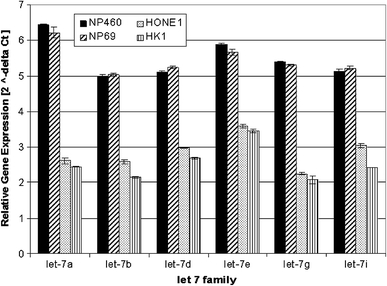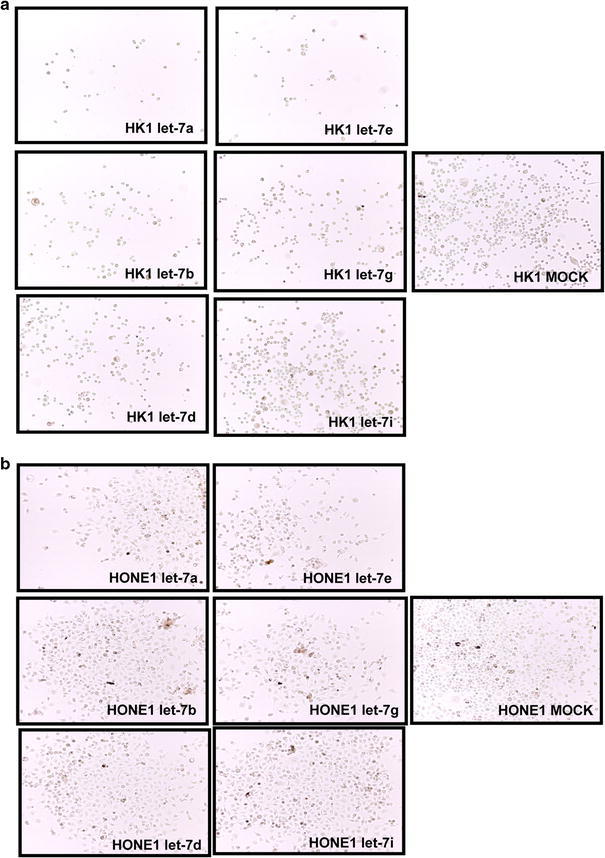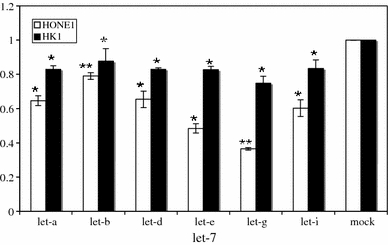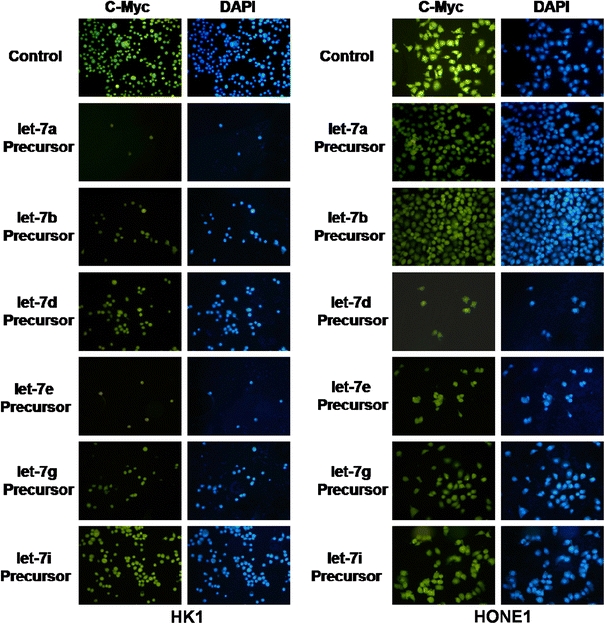Abstract
Aims
This study aimed at evaluating the potential anti-proliferative effects of the microRNA let-7 family in nasopharyngeal carcinoma (NPC) cells. In addition, the association between let-7 suppression and DNA hypermethylation is examined.
Materials and methods
Levels of mature let-7 family members (-a, -b, -d, -e, -g, and -i) in normal nasopharyngeal cells (NP69 and NP460) and nasopharyngeal carcinoma cells (HK1 and HONE1) were measured by real-time quantitative PCR. Cell-proliferation assay and c-Myc immunohistochemical staining were performed on NPC cells transfected with let-7 precursor molecules. In addition, expression changes in let-7 family members in response to demethylating agents (5-azacytidine and zebularine) were also examined.
Results
In comparison with the normal nasopharyngeal cells, let-7 (-a, -b, -d, -e, -g, and -i) levels were reduced in nasopharyngeal carcinoma cells. Ectopic expression of the let-7 family in nasopharyngeal carcinoma cells resulted in inhibition of cell proliferation through downregulation of c-Myc expression. Demethylation treatment of nasopharyngeal carcinoma cells caused activation of let-7 expression in poorly differentiated nasopharyngeal carcinoma cells only.
Conclusion
Our results suggested that miRNA let-7 might play a role in the proliferation of NPC. DNA methylation is a potential regulatory pathway, which is affected when let-7 is suppressed in NPC cells. However, the extent of DNA hypermethylation/hypomethylation in regulating let-7 expression requires further elucidation.
Keywords: MicroRNAs, Let-7, Proliferation, Nasopharyngeal carcinoma, Epigenetic regulation
Introduction
MicroRNAs (miRNAs) are endogenous non-coding RNA molecules (18–25 nucleotides in length), which function as post-transcriptional modulators (Cullen 2004). MiRNAs are expressed as long precursor RNAs. After processing by nuclease, the miRNAs are actively transported into cytoplasm through exportin-5-dependent mechanism. Cytoplasmic miRNAs become functionally mature after further processing by cellular nuclease Dicer. Mature miRNAs are associated with a cellular complex analogous to the RNA-induced silencing complex that participates in RNA interference (Hutvagner and Zamore 2002). The imperfect complementary binding of miRNA to mRNA could promote degradation of the mRNA molecule and/or hindering the translation process. In addition, the partial complementary binding of the miRNA to the mRNA could enhance poly (A) tail removal and thus accelerate mRNA degradation (Wu et al. 2006).
Nasopharyngeal carcinoma (NPC) is a common head and neck cancer. High incidence of NPC is observed in Southern China. In our locality, undifferentiated carcinoma is the most prevalent NPC histology (Wei and Sham 2005). NPC is a multi-factorial disease. Genetic predisposition (Dittmer et al. 2008) and epigenetic alterations (Wong et al. 2004) are significant in the initiation and progression of NPC. In addition, the pathogenesis of NPC is closely linked to Epstein–Barr virus infection. Tobacco and alcohol consumption are critical risk factors as well (Chang and Adami 2006). Recently, it has been shown that miRNA dysregulation is implicated in the carcinogenesis of many human cancers. In cancer cells, the upregulated/downregulated miRNA could function as oncogenic/tumor-suppressing modulators. In case of NPC, however, the critical miRNA changes involved in its carcinogenesis are not yet clearly defined (Chen et al. 2009; Sengupta et al. 2008).
In this study, we investigated the potential involvement of miRNA let-7 in NPC. We showed that NPC cells have lower let-7 levels in comparison with normal nasopharyngeal epithelial cells. To determine whether the reduced let-7 levels have a causative role in NPC, let-7 precursor molecules were re-introduced to the NPC cells. It was found that let-7 could reduce cell proliferation through downregulation of c-Myc. In view of the fact that several let-7 family members are located in CpG islands, we suggested that CpG island methylation is a potential mechanism involved in let-7 suppression in cancer cells. We therefore assessed whether demethylation treatment could elevate the transcript levels of let-7 in NPC cells.
Materials and methods
Cell lines and drugs
NPC cell lines (HK1 and HONE1) and normal nasopharyngeal-derived epithelial cells (NP69 and NP460) were used in the present study. All the nasopharyngeal cells were provided by Professor SW Tsao (Department of Anatomy, The University of Hong Kong). HK1 is derived from well-differentiated squamous carcinoma (Huang et al. 1980); HONE1 is derived from poorly differentiated squamous carcinoma (Glaser et al. 1989). NPC cell lines were maintained in Roswell Park Memorial Institute (RPMI) 1640 medium supplemented with 10% FBS; normal nasopharyngeal-derived epithelial cells were maintained in keratinocyte serum-free medium. Demethylating agents zebularine and 5-azacytidine were obtained from Sigma–Aldrich, St. Louis, MO, USA. In drug treatments, the demethylating agents were diluted to appropriate concentration with RPMI 1640. Analysis was performed after 48-h treatment.
RNA extraction
MiRNA extraction was performed using mirVanaTM miRNA Isolation Kit (Ambion, Austin, TX) following the manufacturer’s instructions.
Quantification of mature miRNA
Individual Taqman-based real-time PCR assays for miRNA let-7a (Assay ID: 000377; target sequence: UGAGGUAGUAGGUUGUAUAGUU), -7b (Assay ID: 000378; target sequence: UGAGGUAGUAGGUUGUGUGGUU), -7d (Assay ID:000380; target sequence: AGAGGUAGUAGGUUGCAUAGU), -7e (Assay ID:000381; target sequence: UGAGGUAGGAGGUUGUAUAGU), -7g (Assay ID: 000383; target sequence: UGAGGUAGUAGUUUGUACAGU), and -7i (Assay ID: 000384; target sequence: UGAGGUAGUAGUUUGUGCUGU) were obtained from Applied Biosystems, CA, USA. Real-time PCR was performed using GeneAmp® Fast PCR Master Mix (Applied Biosystems, CA, USA) and ABI 7900HT real-time PCR machine. All reactions were performed in triplicate. Relative expression levels of mature miRNAs were evaluated using comparative Ct method (Livak and Schmittgen 2001). For comparison of miRNA levels between different nasopharyngeal cell lines, 2−∆Ct method was used. Briefly, transcript levels of target miRNA and housekeeping miRNA was derived from the cycle threshold (Ct) based on the amplification efficiency. The Ct of the target miRNA was normalized to the internal reference miRNA miR-16. ∆Ct (Ct target miRNA − Ct miR-16) was calculated to normalize the input miRNA levels between samples. The respective 2−∆Ct data were then calculated from the ∆Ct. For comparing miRNA levels between the transfected nasopharyngeal cell lines and the mock control, 2−∆∆Ct method was adopted. Here, ∆∆Ct refers to [(Ct target miRNA) − (Ct miR16)] transfected cell − [(Ct target miRNA) − (Ct miR16)] mock control.
Transfection of let-7 precursors
Let-7a, -7b, -7d, -7e, -7g, and -7i precursors were obtained from Ambion. Precursor molecules were transfected into the culture cells using siPORTTM NeoFXTM reagent (Ambion, Austin, TX) according to the manufacturer’s instructions. The medium was changed after 24 h and samples were analyzed after 72 h. For each precursor, transfection was performed in duplicate. Cells treated with the transfection reagent only were used as mock control. To test the transfection efficiency, parallel transfected cells were collected and the changes in mature let-7 levels were measured by real-time quantitative PCR again. The transfected cells with more than 50-fold increase in let-7 transcript levels will be used in subsequent analysis.
Cell-proliferation assay
Changes in proliferation rate were evaluated using CellTiter 96 AQueous One Solution Cell Proliferation Assay (Promega, Madison, WI, USA) according to the manufacturer’s protocol. Cells were cultured on 96-well plate with 10,000 cells in each well. Proliferation rate was examined after 24 h. Absorbance was read by fluorescence microplate Reader (Model 680, Bio-Rad Laboratory, CA, USA) at 595 nm. All samples were examined in triplicate.
Immunohistochemistry
Briefly, culture cells were washed with PBS and fixed with 2% paraformaldehyde overnight. Mouse anti-c-Myc antibody (Santa Cruz, CA, USA) was used as primary antibody at 1:200 dilutions. Goat anti-mouse antibody conjugated with FITC (Santa Cruz, CA, USA) was used as secondary antibody at 1:100 dilutions. The nuclei were counterstained with DAPI. Slides were observed and analyzed with the image analysis system (Nikon eclipse 80i florescent microscope (Nikon, Tokyo, Japan).
Statistical analysis
Data analysis was performed using SPSS® for Windows version 14.0. Quantitative results were compared with paired t-test. All p-values were two-sided. P-values ≤0.05 were considered as statistically significant.
Results
MiRNA let-7 family was significantly reduced in nasopharyngeal carcinoma cells
To identify the potential tumor-suppressing miRNA in NPC cells, we first performed miRNA expression profiling on the NPC cells (HK1 and HONE1) and compared the results with the miRNA expression patterns of normal nasopharyngeal-derived epithelial cells (NP69 and NP460). It was found that the levels of miRNA let-7 family (let-7a, -7b, -7d, -7e, -7g, and -7i) were consistently reduced in NPC cells in comparison with the normal epithelial cells (Fig. 1).
Fig. 1.

Mature let-7 miRNA expression is reduced in NPC cells (HK1 and HONE1) in comparison with normal nasopharyngeal cells (NP69 and NP460). Expression levels of mature let-7 (-a, -b, -d, -e, -g, and -i) was evaluated using the comparative threshold cycle method (2−ΔCT). Transcript miR-16 levels were used as endogenous control. All tests were performed in triplicate. The data were expressed as mean value with standard deviations
Morphological changes in NPC cell lines (HK1 and HONE1) in response to the introduction of let-7 precursor molecules
To elucidate the functional role of let-7 in NPC cells, we introduced the let-7 precursor molecules into the NPC cells and observed the resultant morphological changes. Let-7a, -7b, -7d, -7e, -7g, and -7i precursors were introduced into the NPC cells lines individually. The cultures were monitored continuously under light microscopy for 3 days after transfection. We did not notice any significant changes in size and morphology of the cancer cells. However, the cell numbers in the transfected groups were significantly reduced in comparison with the mock control. Morphologically, the transfected cells were similar to the mock control (Fig. 2).
Fig. 2.

Reduced NPC cells number in response to ectopic let-7 expression. NPC cell lines HK1 (a) and HONE1 (b) were transfected with let-7 precursors. Morphological changes were monitored under light microscopy
Reduced proliferation rate in let-7 precursor transfected NPC cells
We measured the changes in proliferation propensity of the NPC cells in response to the addition of precursor molecules. Each of the six let-7 precursor molecules could reduce the proliferation rate of both HONE1 and HK1 cells individually (Fig. 3).
Fig. 3.

Let-7 inhibits NPC cell proliferation. NPC cells (HK1 and HONE1) were transfected with let-7 (-a, -b, -d, -e, -g, and -i) precursors, and the proliferation rate were measured with MTS assay after 72 h. All tests were performed in triplicate. The data were expressed as mean value with standard deviations. ** P < 0.001, * P < 0.05
Reduced c-Myc expression in NPC cells in response to let-7 precursor
We measured the c-Myc levels in the cell lines after transfection with let-7 precursor molecules. Reduction in c-Myc protein level was observed in all the transfected cell lines (Fig. 4).
Fig. 4.

Let-7 downregulates c-Myc expression in NPC cells (HONE1 and HK1). NPC cells (HK1 and HONE1) were transfected with let-7 (-a, -b, -d, -e, -g, and -i) precursors. After 72 h, the transfected cells were examined by immunohistochemical staining using monoclonal c-Myc antibody. Reduced c-Myc protein levels were observed in NPC cells with ectopic expression of let-7 family members
Upregulation of let-7 by demethylating agents (zebularine and 5-azacytidine)
To validate the association of let-7 downregulation and aberrant CpG island methylation in NPC cells, the let-7 family members levels were measured in the cell lines after demethylation treatment. In HONE1, administration of either 5-azacytidine or zebularine would result in upregulation of mature let-7 expression. Concentration-dependent effects were observed. In comparison with 5-azacytidne, zebularine was more potent in activating let-7 expression. At same IC, zebularine could induce a higher increase in let-7 expression.
In contrast, neither zebularine nor 5-azacytidine was effective in upregulating let-7 expression in HK1. In the HK1 cell line, let-7 expression was mostly reduced in response to demethylation treatment. Only a slight increase in let-7-a, -b, -d, and -e expression was observed when a high dose of zebularine was administered (Fig. 5).
Fig. 5.

Let-7 expression changes in response to 5-azacytidine and zebularine. NPC cells were treated with the demethylation agents separately, and the changes in let-7 members’ expression were measured after 48 h of treatment. Left panel: expression changes in let-7 in HONE1; right panel: expression changes in let-7 in HK1. ** P < 0.001, * P < 0.05
Discussion
Let-7 is a family of tumor-suppressing miRNAs and its expression is reduced in the majority of human malignancies. High level of let-7 expression has an anti-proliferative effect on cancer cells. In head and neck squamous cell carcinoma, it has been reported that low let-7d expression is a prognostic factor for poor survival (Childs et al. 2009). Conversely, in cancers such as breast, lymphoma, and ovarian cancers, several let-7 members are upregulated (Boyerinas et al. 2010). In view of the conflicting expression patterns across human cancers, we first tested the expression levels of let-7 in NPC and normal nasopharyngeal cells. The nasopharyngeal cultures (both NPC and normal nasopharyngeal cells) we tested expressed all the six let-7 family members. We observed substantially lower let-7 levels in NPC cells (HK1 and HONE1) in comparison with the normal nasopharyngeal-derived epithelial cells (NP69 and NP460). We therefore hypothesized that the low let-7 may contribute to the high proliferation rate of NPC cells.
To test the potential anti-proliferative effects of let-7 in NPC cells, we transfected the NPC cells with let-7 precursor molecules individually. The precursors molecules are processed by the NPC cells and become structurally and functionally mature in the cytoplasm after transfection. All the let-7 family members we tested demonstrated anti-proliferative effect on both HK1 and HONE1 cells. The effects are obvious, and the reduction in the total cell number of the transfected cells is noticed by visual inspection under light microscope. To confirm the results, cell-proliferation assay was performed. Among all the let-7 family members, let-7g is most effective in reducing the proliferative activity of both HK1 and HONE1 cells.
To confirm the linkage between let-7 and the reduction in proliferation rate observed in the let-7-transfected cells, immunohistochemical staining on the let-7 target gene c-Myc was carried out. c-Myc is an oncogene involved in proliferation of NPC cells (Wang et al. 2007). Ninety percent NPC tissues demonstrated c-Myc expression (Porter et al. 1994). c-Myc could activate transcription of human reverse telomerase transcriptase (hTERT) and thereby promote proliferation and immortalization (Kirkpatrick et al. 2003). Recent studies also revealed that c-Myc is regulated by the let-7 family (Sampson et al. 2007). Let-7 can downregulate c-Myc expression in several cancers such as colon cancer (Akao et al. 2006). We therefore suggested that high let-7 levels would have a suppressive effect on c-Myc expression. The reduced c-Myc protein levels in response to the ectopic expression of let-7 precursor suggested that let-7 has a role in regulating proliferation through the downregulation of c-Myc expression in NPC cells.
So far, the way in which let-7 expression is suppressed in NPC cells is not clear. Recent studies revealed that genomic region of several let-7 family members is associated with CpG islands (Lu et al. 2007). Thus, CpG island hypermethylation/hypomethylation may be a regulatory mechanism. If the reduced let-7 levels observed in our NPC cells is associated with CpG island hypermethylation, demethylation treatment would be effective in elevating let-7 transcript levels in NPC cells. Since members of the let-7 family are sequentially and functionally similar, suppressing single-member expression would not have significant contributory effects in NPC cells. If hypermethylation is a critical mechanism in inactivating the functional role of let-7 in NPC, concurrent epigenetic inactivation of the let-7 family member should be observed.
Thus, we treated the NPC cells with demethylating agents, 5-azacytidine and zebularine, and monitored the expression changes in let-7 after demethylation treatment. The two demethylating agents we used are cytosine analogs. They are incorporated into the newly synthesized DNA strand during mitosis. These cytosine analogs could bind to cytosine-C5 DNA methyltransferase covalently and alter the de novo addition of methyl group on their cytosine ring (Marquez et al. 2005; O’Dwyer and Maslak 2008). Both drugs alter the formation of methyl cytosine on the newly divided cancer cells and so render DNA demethylation passively.
In general, let-7 expression is upregulated in HONE1 cells, which is derived from poorly differentiated NPC, after demethylation treatment. Both 5-azacytidine and zebularine could upregulate let-7 members’ expression in HONE1 cells. Zebularine is more potent in upregulating transcription of let-7 family members. Interestingly, HK1, derived from well-differentiated NPC, behaves differently in comparison with HONE1 (derived from poorly differentiated NPC). Treatment of HK1 with 5-azacytidine and zebularine (low dose, IC30) has a suppressing effect on transcription of let-7 members. Upregulation of let-7 transcription is only observed when high-dose (IC50) zebularine was used. A slight increase in let-7-a, -b, -d, and -e levels was observed when HONE1 was exposed to zebularine at relatively high concentration. At this moment, we have no explanation on the distinctively different responses of these two NPC cell lines to demethylating agents. We cannot exclude the possibility that let-7 expression is regulated by CpG island methylation in NPC. It seems that poorly differentiated NPC cells are more sensitive to the demethylating agents in comparison with well-differentiated NPC cells. Apparently, CpG island hypermethylation/hypomethylation alone could not fully explain the aberrant dysregulation of let-7 family members in NPC cells.
In conclusion, similar to other human malignancies, let-7 has an anti-proliferative effect on NPC cells and this is partly carried out through its suppressing effect on c-Myc expression. The family members of let-7 in NPC cells are responsive to demethylating agents. However, the differentiation status of NPC cells may affect the response of NPC cells to demethylating agents with regard to their let-7 expression. The different responses of NPC cells to the demethylating agents suggest that the epigenetic regulatory mechanism of let-7 is not a common process across different types of NPC. It is of great interest to elucidate the regulatory mechanisms and functional role of let-7 in NPC carcinogenesis. Further studies are warranted to answer whether demethylation treatment is a suitable regime to restore the dysregulated let-7 expression in NPC.
Acknowledgments
The study was supported by Seed Funding for Basic research, The University of Hong Kong, Hong Kong, China.
Conflict of interest statement
None.
Open Access
This article is distributed under the terms of the Creative Commons Attribution Noncommercial License which permits any noncommercial use, distribution, and reproduction in any medium, provided the original author(s) and source are credited.
Contributor Information
Thian-Sze Wong, Phone: +852-2819-9604, FAX: +852-2855-3464, Email: thiansze@graduate.hku.hk.
On-Ying Man, Email: oymanvenus@gmail.com.
Chi-Man Tsang, Email: anna0226@hkusua.hku.hk.
Sai-Wah Tsao, Email: gswtsao@hkucc.hku.hk.
Ramond King-Yin Tsang, Email: rkytsang@hku.hk.
Jimmy Yu-Wai Chan, Email: jywchan@hotmail.com.
Wai-Kuen Ho, Email: wkho@hkucc.hku.hk.
William Ignace Wei, Email: hrmswwi@hkucc.hku.hk.
Victor Shing-Howe To, Email: howe@netvigator.com.
References
- Akao Y, Nakagawa Y, Naoe T. Let-7 microRNA functions as a potential growth suppressor in human colon cancer cells. Biol Pharm Bull. 2006;29:903–906. doi: 10.1248/bpb.29.903. [DOI] [PubMed] [Google Scholar]
- Boyerinas B, Park SM, Hau A, Murmann AE, Peter ME. The role of let-7 in cell differentiation and cancer. Endocr Relat Cancer. 2010;17:F19–F36. doi: 10.1677/ERC-09-0184. [DOI] [PubMed] [Google Scholar]
- Chang ET, Adami HO. The enigmatic epidemiology of nasopharyngeal carcinoma. Cancer Epidemiol Biomarkers Prev. 2006;15:1765–1777. doi: 10.1158/1055-9965.EPI-06-0353. [DOI] [PubMed] [Google Scholar]
- Chen HC, Chen GH, Chen YH, Liao WL, Liu CY, Chang KP, Chang YS, Chen SJ. MicroRNA deregulation and pathway alterations in nasopharyngeal carcinoma. Br J Cancer. 2009;100:1002–1011. doi: 10.1038/sj.bjc.6604948. [DOI] [PMC free article] [PubMed] [Google Scholar]
- Childs G, Fazzari M, Kung G, Kawachi N, Brandwein-Gensler M, McLemore M, Chen Q, Burk RD, Smith RV, Prystowsky MB, Belbin TJ, Schlecht NF. Low-level expression of microRNAs let-7d and miR-205 are prognostic markers of head and neck squamous cell carcinoma. Am J Pathol. 2009;174:736–745. doi: 10.2353/ajpath.2009.080731. [DOI] [PMC free article] [PubMed] [Google Scholar]
- Cullen BR. Transcription and processing of human microRNA precursors. Mol Cell. 2004;16:861–865. doi: 10.1016/j.molcel.2004.12.002. [DOI] [PubMed] [Google Scholar]
- Dittmer DP, Hilscher CJ, Gulley ML, Yang EV, Chen M, Glaser R. Multiple pathways for Epstein-Barr virus episome loss from nasopharyngeal carcinoma. Int J Cancer. 2008;123:2105–2112. doi: 10.1002/ijc.23685. [DOI] [PMC free article] [PubMed] [Google Scholar]
- Glaser R, Zhang HY, Yao KT, Zhu HC, Wang FX, Li GY, Wen DS, Li YP. Two epithelial tumor cell lines (HNE-1 and HONE-1) latently infected with Epstein-Barr virus that were derived from nasopharyngeal carcinomas. Proc Natl Acad Sci USA. 1989;86:9524–9528. doi: 10.1073/pnas.86.23.9524. [DOI] [PMC free article] [PubMed] [Google Scholar]
- Huang DP, Ho JH, Poon YF, Chew EC, Saw D, Lui M, Li CL, Mak LS, Lai SH, Lau WH. Establishment of a cell line (NPC/HK1) from a differentiated squamous carcinoma of the nasopharynx. Int J Cancer. 1980;26:127–132. doi: 10.1002/ijc.2910260202. [DOI] [PubMed] [Google Scholar]
- Hutvagner G, Zamore PD. RNAi: nature abhors a double-strand. Curr Opin Genet Dev. 2002;12:225–232. doi: 10.1016/S0959-437X(02)00290-3. [DOI] [PubMed] [Google Scholar]
- Kirkpatrick KL, Clark G, Ghilchick M, Newbold RF, Mokbel K. hTERT mRNA expression correlates with telomerase activity in human breast cancer. Eur J Surg Oncol. 2003;29:321–326. doi: 10.1053/ejso.2002.1374. [DOI] [PubMed] [Google Scholar]
- Livak KJ, Schmittgen TD. Analysis of relative gene expression data using real-time quantitative PCR and the 2(-Delta Delta C(T)) Method. Methods. 2001;25:402–408. doi: 10.1006/meth.2001.1262. [DOI] [PubMed] [Google Scholar]
- Lu L, Katsaros D, de la Longrais IA, Sochirca O, Yu H. Hypermethylation of let-7a–3 in epithelial ovarian cancer is associated with low insulin-like growth factor-II expression and favorable prognosis. Cancer Res. 2007;67:10117–10122. doi: 10.1158/0008-5472.CAN-07-2544. [DOI] [PubMed] [Google Scholar]
- Marquez VE, Kelley JA, Agbaria R, Ben-Kasus T, Cheng JC, Yoo CB, Jones PA. Zebularine: a unique molecule for an epigenetically based strategy in cancer chemotherapy. Ann NY Acad Sci. 2005;1058:246–254. doi: 10.1196/annals.1359.037. [DOI] [PubMed] [Google Scholar]
- O’Dwyer K, Maslak P. Azacitidine and the beginnings of therapeutic epigenetic modulation. Expert Opin Pharmacother. 2008;9:1981–1986. doi: 10.1517/14656566.9.11.1981. [DOI] [PubMed] [Google Scholar]
- Porter MJ, Field JK, Leung SF, Lo D, Lee JC, Spandidos DA, van Hasselt CA. The detection of the c-myc and ras oncogenes in nasopharyngeal carcinoma by immunohistochemistry. Acta Otolaryngol. 1994;114:105–109. doi: 10.3109/00016489409126025. [DOI] [PubMed] [Google Scholar]
- Sampson VB, Rong NH, Han J, Yang Q, Aris V, Soteropoulos P, Petrelli NJ, Dunn SP, Krueger LJ. MicroRNA let-7a down-regulates MYC and reverts MYC-induced growth in Burkitt lymphoma cells. Cancer Res. 2007;67:9762–9770. doi: 10.1158/0008-5472.CAN-07-2462. [DOI] [PubMed] [Google Scholar]
- Sengupta S, den Boon JA, Chen IH, Newton MA, Stanhope SA, Cheng YJ, Chen CJ, Hildesheim A, Sugden B, Ahlquist P. MicroRNA 29c is down-regulated in nasopharyngeal carcinomas, up-regulating mRNAs encoding extracellular matrix proteins. Proc Natl Acad Sci USA. 2008;105:5874–5878. doi: 10.1073/pnas.0801130105. [DOI] [PMC free article] [PubMed] [Google Scholar]
- Wang Y, Duan HG, Chen SM, Xiao BK, Cheng J, Tao ZZ. Effect of RNA interference targeting human telomerase reverse transcriptase on telomerase and its related protein expression in nasopharyngeal carcinoma cells. J Laryngol Otol. 2007;121:476–482. doi: 10.1017/S0022215106005019. [DOI] [PubMed] [Google Scholar]
- Wei WI, Sham JS. Nasopharyngeal carcinoma. Lancet. 2005;365:2041–2054. doi: 10.1016/S0140-6736(05)66698-6. [DOI] [PubMed] [Google Scholar]
- Wong TS, Kwong DL, Sham JS, Wei WI, Kwong YL, Yuen AP. Quantitative plasma hypermethylated DNA markers of undifferentiated nasopharyngeal carcinoma. Clin Cancer Res. 2004;10:2401–2406. doi: 10.1158/1078-0432.CCR-03-0139. [DOI] [PubMed] [Google Scholar]
- Wu L, Fan J, Belasco JG. MicroRNAs direct rapid deadenylation of mRNA. Proc Natl Acad Sci USA. 2006;103:4034–4039. doi: 10.1073/pnas.0510928103. [DOI] [PMC free article] [PubMed] [Google Scholar]


